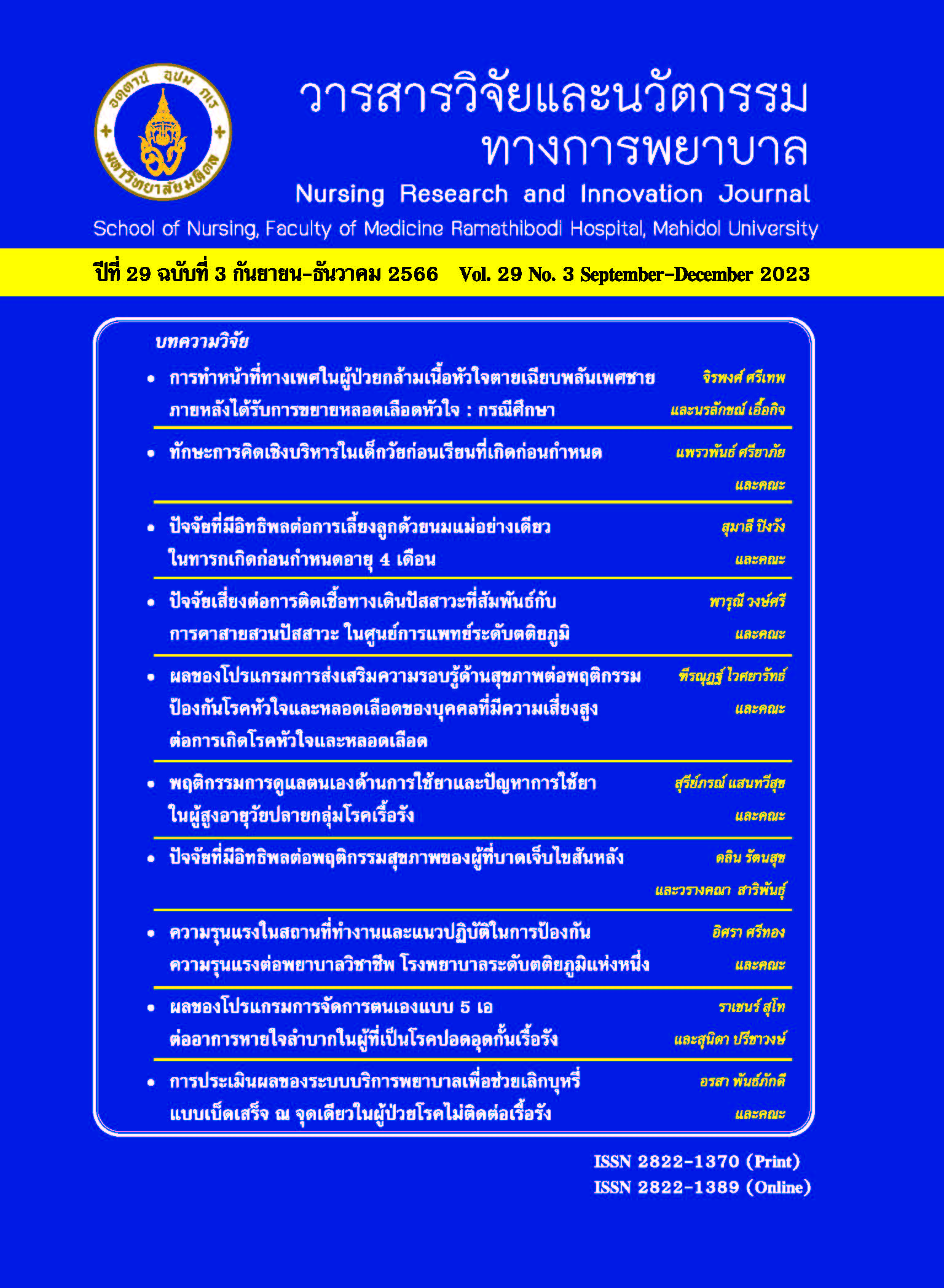ปัจจัยเสี่ยงต่อการติดเชื้อทางเดินปัสสาวะที่สัมพันธ์กับการคาสายสวนปัสสาวะในศูนย์การแพทย์ระดับตติยภูมิ
Main Article Content
บทคัดย่อ
การวิจัยนี้เป็นการศึกษาย้อนหลัง เพื่อศึกษาอัตราและปัจจัยเสี่ยงต่อการติดเชื้อทางเดินปัสสาวะที่สัมพันธ์กับการคาสายสวนปัสสาวะในผู้ป่วยที่คาสายสวนปัสสาวะในหอผู้ป่วยพิเศษและหอผู้ป่วยวิกฤตศูนย์การแพทย์สมเด็จพระเทพรัตน์ โรงพยาบาลรามาธิบดีระหว่างวันที่ 1 ตุลาคม-31 ธันวาคม พ.ศ 2563 จำนวน 994 ราย เครื่องมือวิจัยเป็นแบบเก็บข้อมูลที่ผู้วิจัยสร้างขึ้น ประกอบด้วย 2 ส่วน คือ แบบเก็บข้อมูลส่วนบุคคล และแบบเก็บข้อมูลการใส่สายสวนปัสสาวะ วิเคราะห์ข้อมูลด้วยสถิติเชิงพรรนาและ สถิติการวิเคราะห์การถดถอยโลจิสติก ผลการศึกษาพบว่า อัตราการติดเชื้อทางเดินปัสสาวะที่สัมพันธ์กับการคาสายสวนปัสสาวะเท่ากับ 5.67 ครั้งต่อ 1,000 วันที่คาสายสวนปัสสาวะ พบอัตราการติดเชื้อที่หอผู้ป่วยพิเศษอายุรกรรมและหอผู้ป่วยวิกฤต คิดเป็น 21.11 และ 4.39 ครั้งต่อ 1,000 วันที่คาสายสวนปัสสาวะ ตามลำดับ
การวิเคราะห์การถดถอยพหุโลจิสติก พบว่า ปัจจัยทำนายการติดเชื้อทางเดินปัสสาวะได้แก่เพศ โรคหัวใจวายการติดเชื้อบริเวณอื่นของร่างกาย และจำนวนวันที่คาสายสวนปัสสาวะ โดยสามารถอธิบายความผันแปรของการติดเชื้อทางเดินปัสสาวะได้ร้อยละ 39.2 ซึ่งการติดเชื้อบริเวณอื่นของร่างกายและจำนวนวันที่คาสายสวนปัสสาวะสามารถทำนายโอกาสเกิดการติดเชื้อทางเดินปัสสาวะได้อย่งมีนัยสำคัญทางสถิติที่ระดับ .05 โดยผู้ที่มีการติดเชื้อบริเวณอื่น มีโอกาสเกิดการติดเชื้อทางเดินปัสสาวะ 14.46 เท่าเมื่อเทียบกับผู้ป่วยที่ไม่มีการติดเชื้อ เมื่อควบคุมอิทธิพลของปัจจัยเพศ โรคหัวใจวาย และจำนวนวันที่คาสายสวนปัสสาวะโดยจำนวนวันที่คาสายสวนปัสสาวะที่เพิ่มขึ้น 1 วัน มีโอกาสเกิดการติดเชื้อทางเดินปัสสาวะเพิ่มขึ้น ร้อยละ 7 เมื่อควบคุุม
อิทธิพลของตัวแปรอื่น ๆ ในโมเดล ดังนั้นบุคลากรทางการแพทย์ควรเพิ่มการเฝ้าระวังผู้ป่วยที่คาสายสวนปัสสาวะในกลุ่มผู้ป่วยที่มี การติดเชื้อในระบบอื่นของร่างกาย และจำเป็นต้องคาสายสวนปัสสาวะเป็นเวลานานการทบทวนเพื่อถอดสายสวนปัสสาวะเมื่อหมดความจำเป็นสามารถช่วยลดความเสี่ยงในการติดเชื้อทางเดินปัสสาวะได้
คำสำคัญ : การติดเชื้อทางเดินปัสสาวะ การคาสายสวนปัสสาวะ อัตราการติดเชื้อ ปัจจัยเสี่ยง
Article Details

อนุญาตภายใต้เงื่อนไข Creative Commons Attribution-NonCommercial-NoDerivatives 4.0 International License.
บทความ ข้อมูล เนื้อหา รูปภาพ ฯลฯ ที่ได้รับการตีพิมพ์ในรามาธิบดีพยาบาลสาร ถือเป็นลิขสิทธิ์ของวารสาร หากบุคคลหรือหน่วยงานใดต้องการนำทั้งหมดหรือส่วนหนึ่งส่วนใดไปเผยแพร่หรือเพื่อกระทำการใด ใด จะต้องได้รับอนุญาตเป็นลายลักษณ์อักษรจากรามาธิบดีพยาบาลสารก่อนเท่านั้น
เอกสารอ้างอิง
MohiuddinAK.Lifestyle issues and prevention of recurrent UTIs. Biomed J Sci Tech Res. 2019;21(3):15961-5. doi:10.26717/bjstr.2019.21.003618.
Septimus EJ, Moody J. Prevention of device-related healthcare - associated infections.F1000Res. 2016;5
Rhee C, Phelps ME, Meyer B, Reed WG. Viewing prevention of catheter-associated urinary tract infection as a system: using systems engineering and human factors engineering in a quality improvement project in an Academic Medical Center. Jt Comm J Qual Patient Saf.2016;42(10):447-71.
Faculty of Medicine Ramathibodi Hospital. Infection prevention and control service.Surveillance report 2018- 2020.Bangkok:Ramathibodi Hospital;2020.(inThai).
Chen H, Lee JWY, Yu KCH, Chan CKW, Wong ATY,LaiRWM,etal.Prevalence survey on catheter-associated urinary tract infection(CAUTI)in public hospitals in Hong Kong 2018. Infect Control Hosp Epidemiol.2020;41(3):365-8.
Hollenbeak CS, Schilling AL. The attributable cost of catheter-associated urinary tract infections in the United States: a systematic review. Am J Infect Control.2018;46(7):751-7.
Unahalekhaka A. L-a-pS, Chitreecheur J,.Prevention of multidrug resistant organism infections in intensive care units; 2557 Available from Health System Research Institute web site: https://kb.hsri.or.th/dspace/handle/11228/4265?locale-attribute=th. (in Thai)
Letica-Kriegel AS, Salmasian H, Vawdrey DK,Youngerman BE,Green RA,Furuya EY,etal.Identifying the risk factors for catheter-associated urinary tract infections: a large cross-sectional study of six hospitals.BMJ Open. 2019;9(2):e022137.
Eliakim-Raz N, Babitch T,Shaw E, AddyI, WiegandI,Vank C, et al. Risk factors for treatment failure and mortality among hospitalized patients with complicated urinary tract infection: a multicenter retrospective cohort study (RESCUING Study Group). Clin Infect Dis.
;68(1):29-36.
LiF,Song M, Xu L, Deng B, ZhuS, Li X. Risk factors for catheter-associated urinary tract infection among hospitalized patients: a systematic review and meta-analysis of observational studies. J Adv Nurs.2019;75(3):517-27.
Dudeck MA, Horan TC,Peterson KD, Allen-Bridson K,Morrell G, Anttila A, et al. National healthcare safety network report,data summary for 2011,device-associated module. Am J Infect Control. 2013;41(4):286-300.
Flores-Mireles AL,WalkerJN, Caparon M, Hultgren SJ.Urinary tract infections: epidemiology, mechanisms of infection and treatment options. Nat Rev Microbiol.2015;13(5):269-84.
Werneburg GT. Catheter-associated urinary tract infections: current challenges and future prospects. Res Rep Urol. 2022;14:109-33.
Daniel WW. The Fisher exact test. Daniel WW.Biostatistics: a foundation for analysis in the health sciences. 7thed. New York:John Wiley and Sons; 1999.p.606-11.
Bujang MA, Sa’at N, Sidik T, Joo LC. Sample size guidelines for logistic regression from observational studies with large population: emphasis on the accuracy between statistics and parameters based on real life clinical tata.Malays J MedSci. 2018;25(4):122-30.
Bursac Z, Gauss CH, Williams DK, Hosmer DW.Purposeful selection of variables in logistic regression.Source Code Biol Med. 2008;3(1):17.
Anothayanonth Y. Factors that affecting catheter-associated urinary tract infection in tertiary hospital. J Police Nurs [Internet]. 2020 Jun. 16 [cited 2022 Sep.28];12(1):48-57. Available from: https://he01.tcithaijo.org/index.php/policenurse/article/view/240088.
(in Thai)
Barchitta M, Maugeri A,Favara G, RielaPM, La Mastra C, La Rosa MC, et al. Cluster analysis identifies patients at risk of catheter-associated urinary tract infections in intensive care units:findings from the SPIN-UTI Network.J HospInfect. 2021;107:57-63.
Anggi A, Wijaya DW, Ramayani OR. Risk factors for catheter-associated urinary tract infection and uropathogen bacterial profile in the intensive care unit in hospitals in Medan, Indonesia. Open Access Maced J Med Sci.2019;7(20):3488-92.
Leelakrishna P KRB. A study of risk factors for catheter associated urinary tract infection. Int J Adv Med.2018;5(2):334-9.
Shuman EK, Chenoweth CE. Recognition and prevention of healthcare-associated urinary tract infections in the intensive care unit. Crit Care Med. 2010;38(8Suppl):S373-9.
Association for Professionals in Infection Control and Epidemiology. Guide to preventing catheter-associated urinary tract infections (CAUTIs). [database on the Internet]. [cited 2022 Feb 10]. Available from:https://apic.org.
Farsi AH. Risk factors and outcomes of postoperative catheter-associated urinary tract infection in colorectal surgery patients: a retrospective cohort study. Cureus.2021;13(5):e15111.
GillenJR, Isbell JM,Michaels AD, Lau CL,Sawyer RG.Risk factors for urinary tract infections in cardiac surgical patients.SurgInfect (Larchmt). 2015;16(5):504-8.
RosserCJ,BareRL,MeredithJW.Urinary tract infections in the critically ill patient with a urinary catheter. Am J Surg. 1999;177(4):287-90.
Vincitorio D, BarbadoroP,Pennacchietti L,Pellegrini I,David S, Ponzio E, et al. Risk factors for catheter-associated urinary tract infection in Italian elderly. Am J Infect Control. 2014;42(8):898-901.
Kakaria BA AK, Tushar R. Study of incidence and risk mfactors of urinary tract infection in catheterized patients admitted at tertiary care. Int J Res MedSci. 2018;6(5):tertiarycare. Int J Res MedSci. 2018;6(5):1730-3.
Alam J, Verma PK, Kala S, Rawat V. Incidence and microbiology of catheter associated urinary tract infection in hospitalized patients in a tertiary care hospital in Kumaon region. IJRR. 2020;7(5):114-17.


